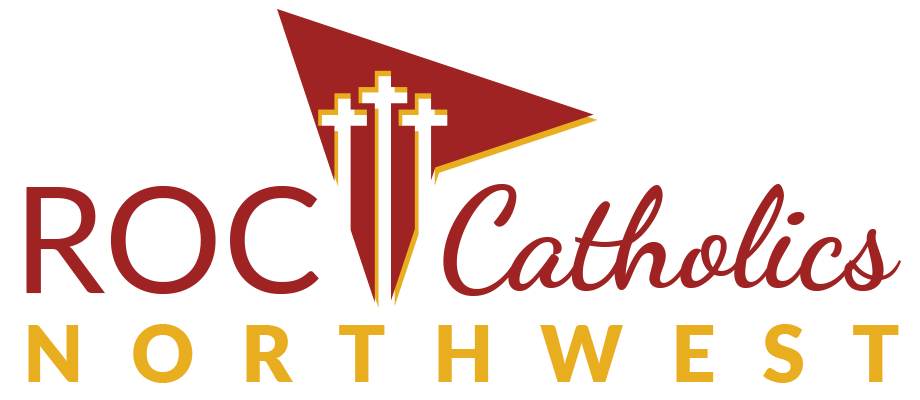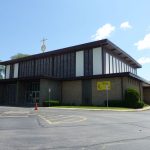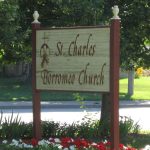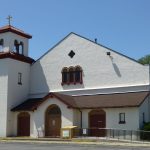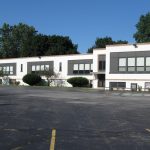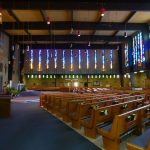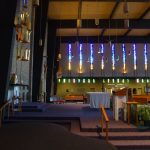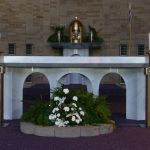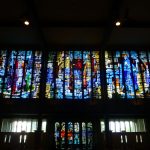3003 Dewey Ave
Rochester, NY 14616
Phone: (585) 663-3230
Office Hours: Monday-Friday 9:00 AM – 3:00 PM
Email:
Website: www.stcharlesgreece.org
Mass Times:
Saturday: 4:00pm
Sunday: 8:30am
Sunday: 10:30am
Monday: 8:00am
Wednesday: 8:00am
Thursday: 8:00am
Friday: 8:00am
Confession Times
Saturday: 3:00pm -3:45pm
Livestream
YouTube Channel: https://www.youtube.com/channel/UCpG-9cpbLyc3i73Kb02NDNQ/videos
St. Charles Borromeo is a Christ-Centered, Catholic worshipping community which serves the diverse needs and celebrates the God-given gifts of our parishioners and the global community in a spirit of joy and generosity.
Since our founding in 1925, our parish has remained dedicated to "being Christ" to our Rochester community. In the words of our namesake, St. Charles Borromeo, we continually strive each day to "preach first by the way you live".
We hope you will join us in this mission
History:
1920 — 1930
They called the 1920’s “The Jazz Age” because it introduced a new style of popular music and a radical change in ballroom dancing that older folks found a bit shocking. Quite a few wondered what the world was coming to.
They need not have worried. Then, as now, good things were happening all over America, usually in unspectacular ways that were not the stuff of headlines. An example: square in the middle of that decade, two Catholic laymen, Leo Lawson and George Pearson from Greece, New York, called on Bishop Thomas Hickey of the Roman Catholic Diocese of Rochester and asked that a new church be built in their section of town, far out on Dewey Avenue. A sparsely-populated area with ample room for growth, it offered affordable, middle-class housing in the five-to-six-thousand-dollar-range that was attracting many young families.
Bishop Hickey, no stranger to church building and all it entailed, was cautiously skeptical. However, he promised to consider such a project if Lawson and Pearson obtained the signatures of 70 Catholic families interested in having a new church. The two men made the rounds and came up with a total of 72 families.
With the minimal requirements met, the work of establishing the parish boundaries of the church got underway. They would include an area stretching from the Genesee River to Mt. Read Boulevard and between Winchester Street on the south to Britton Road on the north. The church was expected to relieve the burden on the surrounding parishes of Sacred Heart, St. John’s, Mother of Sorrows and Holy Cross. Having recently returned from his required ad limina visit to Rome, Bishop Hickey designated “Saint Charles Borromeo” as the name of the new church. The bishop, a great admirer of the saint, had spent considerable time in Milan while on his ad limina visit, since this was the diocese in which Charles Borromeo had accomplished some of his greatest work.
Once the boundaries of the church had been decided upon, there remained the spadework of turning the idea into reality. Assigned to this important task was the Reverend John M. Sellinger, who would serve as its first pastor.
Reverend John M. Sellinger, Pastor (1926 – 1929)
Father Sellinger, a well-liked, hard-working administrator, wasted no time in getting things underway. He made a down-payment of $800 on five-and-a-half acres of farm property on the corner of Dewey Avenue and Maiden Lane, the site where the building would commence. It was a favorable location in the geographical center of the parish, and, as someone aptly observed, “no more than a stone’s throw from Stone Road,” another major thoroughfare.
During this initial phase, Father Sellinger moved in with the George Pearson family until a rectory could be built. Since the Pearsons lived only a short distance from the proposed church site, the pastor found it easier to keep an observant eye on construction while maintaining closer contact with his new parishioners. It was at the Pearson home that the first parish Mass was celebrated on Sunday, November 6, 1925. The first Sunday offering totaled $32.28.
For the balance of the year, and the first half of 1926, various fund-raisers were held to assist in the financing of the first building, a combination church and school. The cornerstone laying of the modest structure was on the Fourth of July, which gave area Catholics a double reason for celebrating. Bishop Hickey officiated, undoubtedly pleased that the saint he admired so much was being given another star of remembrance to his crown.
Father Sellinger, a strong proponent of Catholic education, was determined to open his new school by the fall term. Fortunately, building proceeded rapidly and he managed to meet the self-imposed deadline. With a small faculty composed of the Sisters of Mercy, who volunteered their services, Sister M. Francesca was installed as the school’s first principal and classes began.
Once that top priority had been met, Father Sellinger turned his attention to a proper rectory. There was a small farmhouse on the property, and he had it remodeled to contain his personal living quarters and some small offices for parochial work, all at a cost approaching $10,000. This brought the total debt of the parish to nearly $70,000, but that proved to be only the beginning. Explosive demographics soon outpaced existing facilities. The parish continued to grow in quantum leaps, due in part to its new school, which proved a lodestone to Catholic families moving into the area.
It soon became evident that the school was too small to accommodate the number of students applying for admission. An addition was quickly added at a cost of $15,000, bringing the parish debt to the $90,000 mark. Unfortunately, the timing couldn’t have been worse. The 1929 stock market crash ushered in the nation’s longest economic crisis, followed by massive unemployment. The total annual revenue of the parish dropped to $16,000 — about on a par with the yearly salary of one entry-level production worker today.
Shortly after the market crashed, Father Sellinger was assigned to the University of Rochester as its Newman Club director. It was a sorrowful parting for everyone. The pastor had formed many warm friendships and was naturally concerned about the financial struggle the parish now faced in making ends meet and meeting its debts.
The Reverend William A. Doran succeeded Father Sellinger on November 1, 1929.
Reverend William A. Doran, Pastor (1929 – 1939)
Father Doran displayed an assurance and optimism that were badly needed at the time. While the national economy and the attendant evil of unemployment continued to worsen, he took the bold step of adding to the existing debt by building a convent for the Sisters teaching at St. Charles. Actually, a convent was long overdue. Since the school opened, the Sisters had been commuting to St. Charles classrooms from their temporary quarters in Charlotte’s Holy Cross parish; a makeshift arrangement that had already gone well beyond the temporary stage.
1930 — 1940
In due time, the new and spacious convent was ready for occupancy, and was soon filled close to capacity. The growing number of students required the Sisters of Mercy to augment their ranks and also posed the need for more classrooms. In September of 1931, to meet this problem, Father Doran was able to purchase a portable school building from the Greece Board of Education for the nominal sum of $25. It was erected near the existing school by parish volunteers at a total cost of $78.62. One could truly classify the much-needed addition as “bargain of the year.” A few years later, Father Doran purchased another portable building from the Board of Education for a small sum; this one was to be used for parish recreational activities.
By 1938, the Great Depression seemed to be weakening. The church’s financial affairs were slowly improving. The unemployment figures began to dip, church attendance was rising, and progress was being made in paying off the parish debt. In short, things began looking good.
Then, tragedy struck. On Holy Thursday, April 14, 1938, fire broke out in the school around suppertime, and was soon out of control. Father Doran fought his way through the smoke to bring out the Blessed Sacrament from the church, and the Sisters of Mercy managed to salvage a few books and supplies from the school section, until forced to withdraw when the flames grew more threatening. Volunteers from three Greece fire stations and one fire company from Rochester responded to the alarm and eventually brought the fire under control. The school, however, was completely ruined, with damages estimated at $22,000; equivalent to more than a quarter million dollars today.
Thanks to the efforts of the fire fighters, the church portion of the structure was saved, except for some minor water damage. The indomitable Father Doran saw to it that Good Friday services were held on schedule.
Meanwhile, an emergency fund-raising drive got underway, and $6,000 was quickly collected to start repairing minor damage to the church and to reconstruct the badly-damaged school. The reconstructed school was fully-operational, and the freshly painted church never looked better.
With things back on track, and the difficult decade of the ’30s coming to a close, Father Doran was transferred to St. Ann’s church in Palmyra, New York. Again, the parting was a sorrowful one. Father Doran had earned the admiration and respect of all for his steady guidance and comforting presence through some extremely difficult years.
His replacement was the Reverend Robert E. Keleher, who began his long tenure on a quietly efficient note. He supervised the careful landscaping of the grounds to make them more visually pleasing, installed a new stoker in the central boiler room, which serviced both church and school, and undertook a comprehensive census of the entire parish.
The drive to build a new church and school suffered a setback. As so often happens, the unexpected march of events frequently forces a change of plans, and so it was in this case. The nearby Eastman Kodak Company’s continuing expansion had brought a surge of workers in to the town of Greece and the parish confines. That the school had to be again enlarged, if the growing number of applicants were to be accommodated, soon became starkly evident. Thus, the imperative need for an addition to the school temporarily placed on-hold the plans for a new and larger church Once the decision had been made, ground was broken for the school addition on December 9, 1939. Slightly more than a year later the new, much enlarged school relieved the overcrowding.
1940 — 1950
Under Father Keleher, the church was completely remodeled along Spanish Mission lines. The sanctuary was placed at the opposite end of the church, and a choir loft was added. During the alterations, Mass was conducted in the school hall. The work was completed in time for Christmas Mass in 1952.
Another red-letter day took place on October 4, 1947, when Father Keleher announced that the parish debt of $100,000 had been completely liquidated. What made it truly remarkable was the fact that the debt liquidation had been accomplished without the aid of any special fundraising campaign. Father Keleher’s deft and prudent management of parish funds was a major factor in bringing this about.
An active parish, however, rarely rests on its laurels. Only a month later, another ambitious project got underway with a two-fold objective; to provide a new church and add more classrooms to the school. The drive started November 9, 1947 and came to a close November 24th, having exceeded its goal by raising $53,647 from 900 wage-earners. With such a respectable reserve fund to start with, a new and larger church seemed in the offing. But it was not to be — at least yet.
1950 — 1960
An exploding population in the town of Greece, plus a post-war increase in the birth rate caused a drastic change of plans. Accommodating the record number of school applicants at St. Charles required a more extensive addition to the school than was expected. Regrettably, the new church was placed on hold and the building of the school addition got underway December 9, 1949. When completed in 1950, the number of classrooms had been increased to 16, and the faculty to 16 Sisters of Mercy. With more than 2,600 people attending Sunday Mass, the parish reached its 25th anniversary with renewed confidence that a larger and more beautiful dwelling place housing the Son of God would someday become a reality.
That day was still far in the future; meanwhile, the parish was divided twice, in order to better accommodate Catholics pouring into the area. These divisions took place when Our Lady Of Mercy parish was established and a few years later, Holy Name of Jesus.
During this period, it was also necessary to enlarge the convent to house the growing number of teaching sisters. Plans were drawn and the work got underway in April 1950, but unforeseen difficulties resulted in numerous delays. As a consequence, the sisters had to “board out” at Holy Cross and in our own portable building until work on the convent was completed. The total cost of the refurbished convent came to a staggering $300,000. Once again St. Charles parish began working to reduce this formidable new debt.
1960 — 1970
At long last, on November 8, 1963, plans for a new church hit the drawing board and the old campaigners of the parish began making the rounds, ringing doorbells and obtaining pledges to fund this largest project of them all.
In the true spirit of the parish, the campaign was highly successful and allowed construction to begin. At an estimated cost of $678,000, the sparkling new edifice was completed and opened for services by Easter Sunday, 1967. Simultaneously,the old church was remodeled to contain school offices and a large gym with a regulation-size basketball court. The gym has since served the needs of not only the school’s physical education program, but also many parish, C.Y.O. and community activities.
The winds of change blew briskly through the Catholic world during the ’60s. Pope John XXIII convoked the Second Vatican Council — popularly called “Vatican II” — which ran from October 11, 1962 to December 8, 1965. Its fundamental aim was to explore ways and means in which the Church could more fully accomplish its mission in the contemporary world. This historically-significant orientation toward renewal and reform brought with it a liturgy in the vernacular and many new roles for the laity. Some found the changes discomfiting, but the majority adjusted to them with surprising aplomb, and slowly-rising appreciation for the new order of things. Other changes of more local significance also took place. Father Keleher was made a papal honorary prelate with the title “Reverend Monsignor.”
In accordance with a new rule governing mandatory retirement of pastors at age 70, Monsignor Keleher stepped down from his post in 1968. It was not to be the end of his ministry. By assuming the role of Pastor Emeritus at St. Charles, he continued to serve in his priestly functions with no change of pace, and proved to be of great help to his successor.
His replacement as pastor was the Reverend L. John Hedges, who came to the parish from the University of Rochester, where he served as chaplain.
Reverend John L. Hedges, Pastor (1968 – 1978)
An affable, easily-approached man with a well-honed sense of humor, leavened with compassion and understanding, the new pastor quickly became popular with his parishioners. Under his leadership, the parish was quick to participate in the diocese’s newly created Deacon Intern Program; one of the first deacons being Father Edward Palumbos, who was destined to return to the parish as its pastor many years later.
1970 — 1980
A somewhat unique enterprise took place in 1973, which served to underscore the cordial relationship between town and parish. Greece officials had been using a small pre-fab home, dubbed “The White House,” as a youth-oriented drug rehabilitation center. The town subsequently built a larger facility elsewhere for this activity, and requested permission to relocate the pre-fab onto church grounds where it could be used for various youth programs. Although other sites had been considered and pursued by the town, with negative feedback, Father Hedges agreed to the proposal, which called for a token dollar-a-year lease arrangement. The “White House” was then relocated to the East side of the parish complex, facing Dewey Avenue, where it stood until the early 2000s.
During this time, the “Heindl House,” named for Fr. Elmer Heindl, housed a Pre-K program for the school, as well as other childcare and youth activities. Father Heindl had always paid attention to these youngest members of our parish family and it was a well-deserved tribute.
Reverend Elmer W. Heindl, Associate Pastor (1980 – 2006)
Perhaps more disturbing in the early ’70s, was the rising cost of education at every level. Parochial schools became increasingly vulnerable to this alarming trend, with the sudden dearth in religious vocations, particularly among the teaching sisters. This caused a steady rise in school tuition, due to the need for teacher replacements from among the laity. St. Charles School did not escape the trend and its attendance problems, including a gradual slippage in student enrollment that eventually brought the number of pupils down to the 400-mark.
With the coming of the first lay school administrator, Salvatore “Sam” Musso, in 1974, new ideas to boost enrollment were introduced. A pre-school program for three- to four-year-olds was begun. The Parish Council adopted the philosophy of “a Catholic education for every child whose parents wished it.” A federally-funded hot lunch program was also made available to students.
Father Hedges also showed an active interest in religious education for adults in the parish and instituted evening classes for those interested in learning more about their faith. These classes became quite popular and were a forerunner to the Catechumenate and R.C.I.A. of the present day.
1980 — 1990
After ten dedicated years at St. Charles, Father Hedges was transferred to St. Helen’s in Chili/Gates, leaving a rich heritage and many fond memories in his wake. Replacing him was the Reverend Emmett J. Halloran, who had been rector at King’s Prep and came to us with wealth of experience. Under Father Halloran’s competent leadership, the parish instituted a Retreat and Renewal Program, Bible study courses, and Home Masses in newly established “Neighborhood Communities” within parish boundaries, plus other spiritual enrichment programs offered at various times of the year.
Reverend Emmett J. Halloran, Pastor (1978 – 1988)
Father Halloran was also gratified to see a rise in the school enrollment, under the competent leadership of its principal, Barbara A. Williams. To alleviate yet another space crunch in its classrooms, it was decided to house Junior High students (seventh and eighth grades) at the former Our Lady of Mercy school building a mile or so away. It was an unprecedented move which showed considerable promise. Our Lady of Mercy school had been closed due to falling enrollment and after considerable soul-searching, it was leased by our parish to become an adjunct of St. Charles School. As such, it was reopened in September 1981 when the first Junior High classes began on the site.
Within the political spectrum, it was felt that our own expansion was justified, since the matter of tuition tax credits was expected to be brought to the floor of the 97th Congress, with a good chance of passage. The measure had the full endorsement of President Ronald Reagan and exhibited strong grass-roots support. Unfortunately, the bill failed to pass by a narrow margin. There would be no tuition tax credit relief for Catholic school parents in the foreseeable future. Despite this disappointment, school enrollment continued upward, and even exceeded a projected enrollment of 850 for the 1983-1984 school year.
To everyone’s regret Father Halloran was transferred to another parish in 1988. Our new pastor, The Reverend Terrance Fleming, was joined that same year by the Reverend Joseph Cantonese.
Reverend Terrance Fleming, Pastor (1988 – 1992)
It was an interim appointment for Father Cantonese, who was suffering from a hearing loss that would soon require prolonged remedial treatment. During his stay in our parish, and despite his deteriorating hearing loss, Father Cantonese made a significant contribution to the parish. It came about in the spring of 1991 when questions arose concerning what should be done with the nearly empty convent, now that most of the teaching sisters had departed. The happy inspiration to invite Father Francis Blighton to develop a ministry of spiritual direction and prayer in the convent building was acted upon, and the invitation accepted.
1990 — 2000
Ordained in 1974, Father Blighton came to us from sick leave, after suffering a heart attack while serving at the Glens Falls Spirituality Center. After agreeing to accept the new ministry, he became the founding Director of the newly named Borromeo Prayer Center.
It was a formidable undertaking. The convent was in poor repair and required considerable renovation. The work was done mostly by parish volunteers who gave unstintingly of their time, labor, and expertise to transform the building into an eminently suitable center for week-end retreats, prayer groups, Bible study seminars and other spiritual get-togethers.
In June 1993, a full time administrator, Mrs. Patricia Scouten, was appointed at the Prayer Center, and by January 1994, the work of refurbishing the entire building was completed. It was not long before churches and organizations of many faiths began coming to the Center for retreats; quite a few of whom began attending other programs and workshops the Center had to offer.
On January 11, 2000, a day marked by shock and profound sorrow on the part of all those who came to love and respect him, Father Francis Blighton died suddenly, of a heart attack, at the age of 54. For years, he had uncomplainingly suffered from a heart ailment, but never allowed it to interfere with his ministry. He remains an inspiration to members of this parish and will not soon be forgotten. The legacy of Fr. Blighton continued in the ministry of the Borromeo Prayer Center until it closed, and this legacy has touched the lives of thousands of people who passed through its doors.
With the departure of Father Fleming in 1992, Father Edward Palumbos (“Father Ed”), our one-time deacon, returned to us, and was installed as pastor.
Reverend Edward Palumbos, Pastor (1992 – 2001)
He brought with him a spirit of buoyant innovation, and quickly moved the parish administration into the computer age. The relatively new and sometimes perplexing tools of the digital revolution soon became an operative part of the rectory. These were changing times in a changing church, and Father Ed saw to it that the parish took its place in the vanguard of those changes.
The new pastor had not been long with us when Bishop Matthew Clark announced the convening of a Diocesan Synod, made up of priests, religious and lay persons, for the purpose of considering and taking action on matters affecting the life and mission of the Church in the Diocese. From the inception of the Synod in early 1992, Father Ed organized and led the parish synod team through all stages of this important event, until the successful conclusion of the General Synod, held at the Rochester Riverside Convention Center on October 1-3, 1993. It proved to be a very inspirational and joyous event, in which all the challenges confronting the diocese in the closing years of the 20th Century were considered in detail, and various courses of action decided upon on how they would be met.
This new technology age gave Father Ed another way of reaching people. He was well aware that as our young people graduated from high school and moved to college, they often lost touch with the church. He asked them for their e-mail address and every week he would send them the “Said Ed” feature from the front of the church bulletin. This gave the young people a sense of belonging to the parish even though they may be far away. It also gave them a chance to ask questions.
Father Ed instituted a new progam of Stewardship of the Poor. He proposed that the parish give a certain percentage of its weekly offering to the poor. A vote was taken and the parish overwhelmingly approved the resolution. The percentage was set at 3%. Each week a different organization was chosen. This program still is in existence today.
2000 — 2010
In 2001 Father Ed was transferred to Assumption Parish in Fairport. Father Timothy Brown was appointed pastor.
Reverend Timothy Brown, Pastor (2001-2007)
The bishop announced a three year program for raising funds for the diocese to pay bills. It was called “Partners in Faith”. The goal was to raise $50,000,000. Each parish would keep 25% of the money it raised. The parish had to decide what the money was to be used for. St Charles’ goals were primarily centered around refurbishing the church, and to hire a Youth minister. The parish pledged $800,000. Renovation to the 40 year old church included new pews, relocation of the Baptismal Font to the center isle with a flowing fountain, and permanent places for displaying the Holy Oils and the Pascal Candle. The renovation was completed in 2006.
The year of 2006 was a financially challenging year. St. Charles was facing an estimated short fall of about $100,000 for the year at the mid-year review. Due to the diligent work of all organizations in the parish and the appeal from Fr. Brown, the parish stepped up again. Year end deficit was about $25,000. Most of the increased costs came from rising fuel costs. With the direction of Father Brown the parish staff and parish council were faced with some hard decisions. It was clear the cuts had to be made to have a balanced budget 2006 – 2007. Each department was asked how to reduce their costs. In a true Christian manner the new budget was passed. It was not without pain. Several much-needed positions were eliminated. Parish volunteers stepped forward to help with the work load. This may be a blessing in disguise. Many people who volunteered are finding great rewards in their new ministries that they may never have considered.
The Youth Group was rekindled under the leadership of Miss Beth Blodgett. The junior high group is called “Light” (Living in God’s Holy Truth) and the senior high group is called “Shine”, (Students Helping Inspire New Evangelization). The group has attended several conventions and conferences, including the three Diocesan Youth Conventions and the National Catholic Youth Conference in Atlanta in 2005. Over 700 youths from the Diocese of Rochester attended NCYC, including Bishop Mathew Clark and Father Doug Della Pietra. Fund Raising for events is accomplished in many ways, such as the Clothing Drop Box, garage sale and car washes. A Youth room was established off the school cafeteria in 2006. The youth group collaborates with the Parish Family Enrichment program. They have also adopted Military personnel as pen pals. The youth group ministry extends beyond the parish. They make “Chaplet” rosaries for a National Catholic youth speaker. They are passed out to youth across the country when he speaks.
St. Charles School underwent a major change in 2005. St. John’s on the Ridge’s School was closed and consolidated with St. Charles School and was renamed Catherine McAuley School. This was due to decreasing enrollment in both schools.
On September 1, 2007 Fr. Timothy Brown announced that he had written a letter to Bishop Clark asking to be relieved at St. Charles after his six year stay. Later that night at about 6PM, a woman drove her car into St. Charles Church causing damage to the vestibule on the Dewey Ave side.
Fr. James Lawlor, a retired former assistant at St. Charles in the late 1970’s, graciously accepted the role as Temporary Parochial Minister. He served our parish until June 2008, when the position of Pastor was filled by Fr. John Firpo.
Reverend John Firpo, Pastor (2008-Present)
Veteran’s Day 2007 was a sad day for St. Charles. During the afternoon hours it is assumed several people entered the church looking to steal things of value. They managed to remove the tabernacle from the altar and take it into the sacristy where they tried, in vain, to open it. The tabernacle was severely damaged, but was successfully repaired.
The month of November has another sad topic. After much agonizing thought it was decided that the Borromeo Prayer Center should close in June 2008. A number of issues had arisen that contributed to this decision. The Center had never been self-sufficient, budget-wise, and a number of major renovations were needed. New windows, updated electrical service and roof repairs were a few of the items that would have needed to be addressed. Since the Prayer Center Administrator, Patricia Scouten, was retiring that June, it was decided that this would be the appropriate time to close the Center. After a committee reviewed the various options, the center was demolished, as refurbishing the structure was deemed uneconomical.
January 19, 2008 was a sad day for the school. Bishop Clark announced that it would be one of thirteen schools in the Diocese that would be closed at the end of the school year. The closings were due to financial woes, and in order to keep Catholic education available in the Diocese by re-allocating available funds to schools that were financially viable.
On Saturday, March 15, 2008, Fr. John Firpo’s appointment as pastor was finalized. This year, several milestones were attained at St. Charles. Sr. Miram Nugent celebrated her Golden Jubilee on May 17th. A special ceremony was held at the Saturday night liturgy attended by many of her classmates, family and friends. A reception was held following the Mass in the parish gym, followed by a dinner for her family in the cafeteria. Fr. Thomas Statt celebrated his Golden Jubilee on June 1st. After the Mass, a reception was held in the parish gym for family and friends. Brother Charles Varnak, CSC celebrated his 60th anniversary on August 16th. We are truly blessed to have been able to be a part of these celebrations.
On September 16th, 2008, we were pleased to receive Fr. Mark Brewer as a Parochial Vicar at St. Charles. He came to us from St. Michael’s in Newark.
In the midst of these celebrations came a year of great transitions and needed changes. One of the first tasks Fr. Firpo was to accomplish was the sign off on the demolition of the dilapidated Borromeo Prayer Center/Former Convent. Despite its demolition, many of its programs would continue. That same year, Fr. John sought to better understand the needs of the parish and its parishioners through a unique congregational survey. This unique survey would help the parish staff orient the direction the parish as it sought to reclaim its identity. With the prayer center and school now closed, this was most definitely a year of decisions and change.
In 2009, a 5 year capital campaign was presented to address much needed repairs in the facility and on the grounds. Fr. Firpo was on a mission to return the parish to financial and physical sustainability for the future. This was seen most clearly in the mission text of the entire project, 'Joining together to secure our future'. With enthusiastic support the proposal was adopted by the parish and work began.
2010 — 2020
Thanks to the grace of God and the generous support of the parish community, the estimated funds required to fund such a massive project were far exceeded. Despite an initial goal of $600,000, the parish came together and raised over 1 Million dollars!
Projects completed included, but were not limited to, a new roof for the rectory, a new boiler for the school building, an expanded parking lot, a repainted/designed church interior. New A/C units, a new boiler, developing handicap access across all facilities, and more! Together, we secured our future for the foreseeable future!
To recognize the contributions of our generous parishioners, a large 'Tree of Life' recognition plaque was designed and placed in the narthex of the parish as you first enter the front doors.
2010 brought new opportunities to serve as well with the arrival of Alcoholics Anonymous (AA) Meetings taking place regularly in our facilities. This parish family has always had a huge heart for those struggling with substance abuse.
In the coming years, numerous parishes in the area began to struggle financially and were left with no other option than to merge or close. In our neighborhood, this began with the closing of Our Lady of Mercy in 2009, leading to over 25% of their parishioners becoming St. Charles parishioners. In 2013, Apostolic Administrator Cunningham appointed Fr. Firpo over the Parish of Holy Name of Jesus as the Parochial Administrator while maintaining his pastoral position at St. Charles. His job was to work with the parish council to assess the future of the parish and determine long-term plans and viability. Together, the parishes worked sharing insights and holding innumerable meetings and Q&A sessions.
Despite best efforts, it was determined that Holy Name of Jesus was to close and become absorbed by St. Charles Borromeo in 2014 by decree of the Bishop. Fr. John, recognizing the emotional difficulty in a parish closing for the parishioners, sought to bring a piece of each church that had closed to St. Charles to help the Parishioners recognize this was a unified endeavor and that this was their church home now too. This included the presiders cross for processionals from Holy Name of Jesus parish and the statue of Our Lady from Our Lady of Mercy Parish. It was a sign of unity in purpose and faith. With the absorbing came Deacon Dick Lombard from Holy Name of Jesus. Deacon Dick has continued to serve selflessly to this day.
The decade also brought a unique and widespread growth in technology never before seen. Social media, the internet, wireless, and the rise of the cell phone marked the decade and presented both opportunities and challenges never before seen to ministry.
In 2013, Jill Kinsella joined the parish staff and brought an air of freshness to a now dwindling youth program. Over her tenure (2013-2020) the youth program would rise to over 40 youth! These youth were active and involved as altar servers, volunteers at the pancake breakfast, and were consistent attendees at NCYC every year!
In 2015, the Parish was blessed with the arrival of Fr. Pius Pathmarajah from St. John's on the Ridge. His experience with the Knights of Columbus and on the Marriage Tribunal has brought a unique perspective and experience to the parish.
In 2018, the parish staff recommitted to its commitment to combat local substance abuse by partaking in 'Narcan' training. 'Narcan' is a specialized treatment that can help resuscitate a victim of an overdose. being trained helps us to better serve and protect our community.
2020 — Present
2020 was a year that will forever live in history. Almost instantaneously, the parish was shut down like everyone else by the Coronavirus Pandemic (COVID-19). For the first time since the Spanish Flu, all programs, masses, and events within the parish and much of the country were immediately suspended until further notice. navigating this pandemic would be one of the greatest challenges the parish had ever faced.
Immediately, the staff forged ahead to ensure the faithful would not suffer too much spiritually as a result. Purchasing and learning how to use live stream cameras was only the beginning. Together, the staff learned how to navigate seemingly daily changes to guidance and laws.
In July 2020, the Bishop gave the approval to return to in-person worship across the diocese. While certainly different in appearance, the joy of the congregation to return to in-person worship was tangible. Thus began a year of adaptive changes and prayerful patience.
In November, the Parish hired Tyler Davis to serve as its new Youth Minister. In the midst of a pandemic, Tyler was faced with a difficult challenge, but remained committed to the success of the youth and the program as a whole. A convert to the Catholic faith, Tyler brought passion, experience, and a deeply rooted commitment to the faith.
Like it's 20th century predecessor, 2020 would begin the decade roaring.
